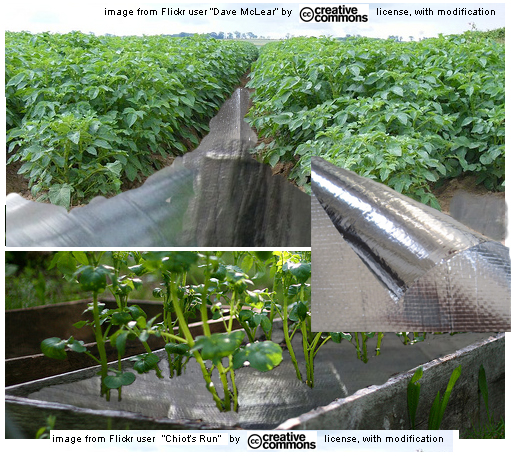Metallized Fabric as Ground Cover
Jump to navigation
Jump to search
Note: This is an open source invention, published first here on the Open Source Ecology wiki. The invention relates to the use of metallized fabric or foil as ground cover for agriculture. This has the effect that sunlight is blocked from reaching the soil, thus preventing growth of weeds. The metallization will also act as a reflective mirror, redirecting diffuse light onto the crops, thereby increasing photosynthesis and crop yields.
Specifically, this invention:
- may be referred to as "SilverSoil" (although possible trademark implications have not been investigated at this point).
- especially makes use of woven fabric produced from non-biodegradable materials such as woven fiberglass and woven Basalt Fibers.
- also includes metallized plastic foils, i.e. mylar (including, but not limited to: polyethylene, possibly UV-stabilized). These films are much more economical than metallized fiberglass. However, plastics are generally not as durable and will degrade over time, especially when exposed to sunlight (UV) for extended periods of time. Plastics may also leach toxic substances into the ground and into food (this is less of a concern with polyethylene, more so with others)
- includes possible implementations where the sheets have "open edges", with non-woven fibers sticking out. These can then be put around the stems of the crop from both sides, assuring that the light-blocking effect (and hence weed-reducing effect) will also be present in this area. This could make removal of sheets at harvest time more difficult but provides improved ground cover.
- is expected to prevent erosion from rain by slowing down raindrops before they hit the ground. During rain, the exposed soil particles are "bombarded" with raindrops – an important mechanism of erosion. The material absorbs most of the force with which the raindrops fall, and the water can then slowly be absorbed by the soil.
- is applied only temporarily. The sheets are collected before harvest and are rolled up for storage until the next use.
- will prevent evaporation of moisture from soil by several mechanisms: 1.) it reflects sunlight, thus preventing excessive warming of soil by sunlight; 2.) prevents wind from reaching the soil. Lower evaporation will likely reduce irrigation needs.
- may be coated with a polymer covering. This includes an implementation with a layer of fluoroplastic polymer (incl. but not limited to ETFE, PTFE) to give the material self-cleaning properties.
- may be applied to the field manually, by bicycle, or by other forms of mechanization such as a tractor (e.g. LifeTrac)
- can be applied to potato fields after hilling
- may be combined with a potato hilling process at the same time that the material is applied to the field
- may be applied to the walls of an Earth Sheltered Greenhouse or underground greenhouse, such as the Walipini, in order to reflect sunlight down to where plants are growing.
